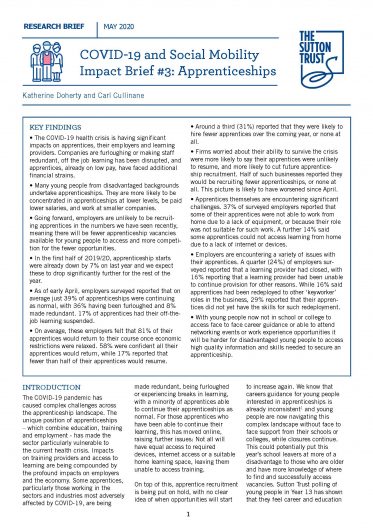• The COVID-19 health crisis is having significant impacts on apprentices, their employers and learning providers. Companies are furloughing or making staff redundant, off the job learning has been disrupted, and apprentices, already on low pay, have faced additional financial strains.
• Many young people from disadvantaged backgrounds undertake apprenticeships. They are more likely to be concentrated in apprenticeships at lower levels, be paid lower salaries and be vulnerable to furloughing and redundancies a result of the health crisis.
• Going forward, employers are unlikely to be recruiting apprentices in the numbers we have seen recently, meaning there will be fewer apprenticeship vacancies available for young people to access and more competition for the fewer opportunities.
• In the first half of 2019/20, apprenticeship starts were already down by 7% on last year and we expect these to drop significantly further for the rest of the year.
• As of early April, employers surveyed reported that on average just 39% of apprenticeships were continuing as normal, with 36% having been furloughed and 8% made redundant. 17% of apprentices had their off-the-job learning suspended.
• On average, these employers felt that 81% of their apprentices would return to their course once economic restrictions were relaxed. 58% were confident all their apprentices would return, while 17% reported that fewer than half of their apprentices would resume.
• Around a third (31%) reported that they were likely to hire fewer apprentices over the coming year, or none at all.
• Firms worried about their ability to survive the crisis were more likely to say their apprentices were unlikely to resume, and more likely to cut future apprenticeship recruitment. Half of such businesses reported they would be recruiting fewer apprenticeships, or none at all. This picture is likely to have worsened since April.
• Apprentices themselves are encountering significant challenges. 37% of surveyed employers reported that some of their apprentices were not able to work from home due to a lack of equipment, or because their role was not suitable for such work. A further 14% said some apprentices could not access learning from home due to a lack of internet or devices.
• Employers are encountering a variety of issues with their apprentices. A quarter (24%) of employers surveyed reported that a learning provider had closed, with 16% reporting that a learning provider had been unable to continue provision for other reasons. While 16% said apprentices had been redeployed to other ‘keyworker’ roles in the business, 29% reported that their apprentices did not yet have the skills for such redeployment.
• With young people now not in school or college to access face to face career guidance or able to attend networking events or work experience opportunities it will be harder for disadvantaged young people to access high quality information and skills needed to secure an apprenticeship.
